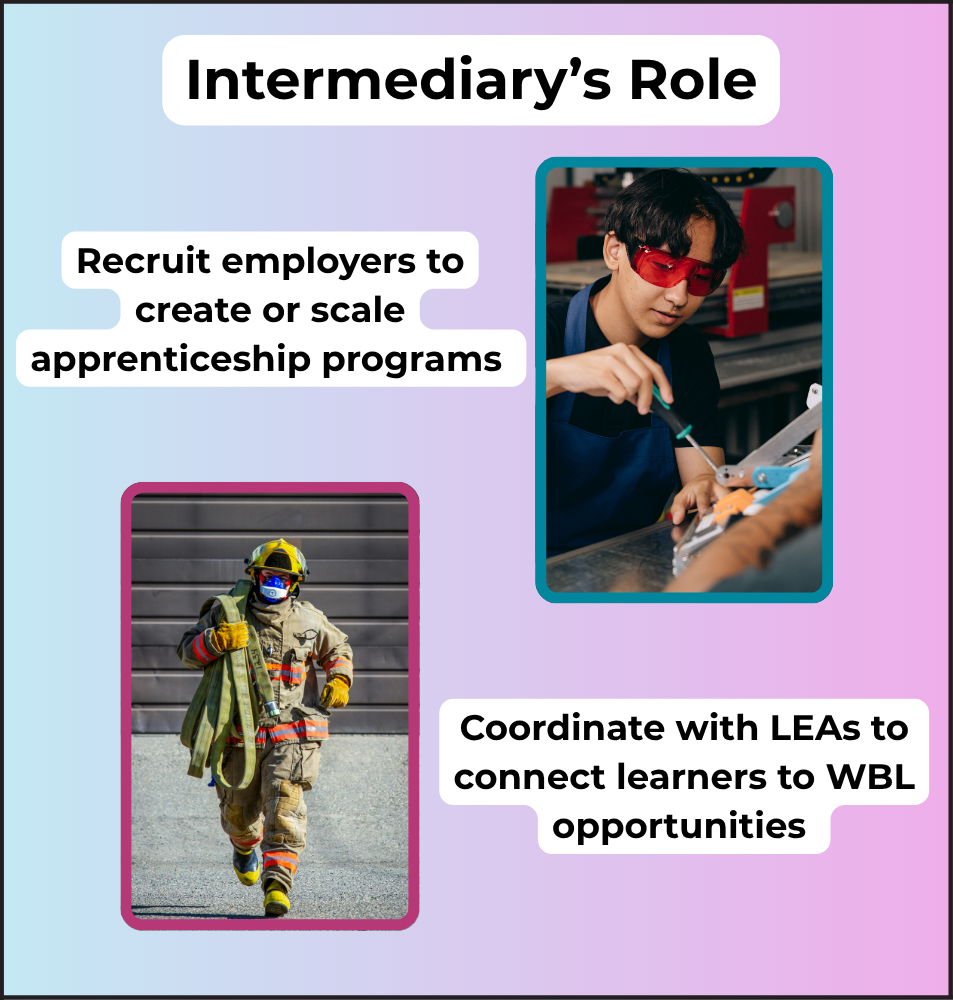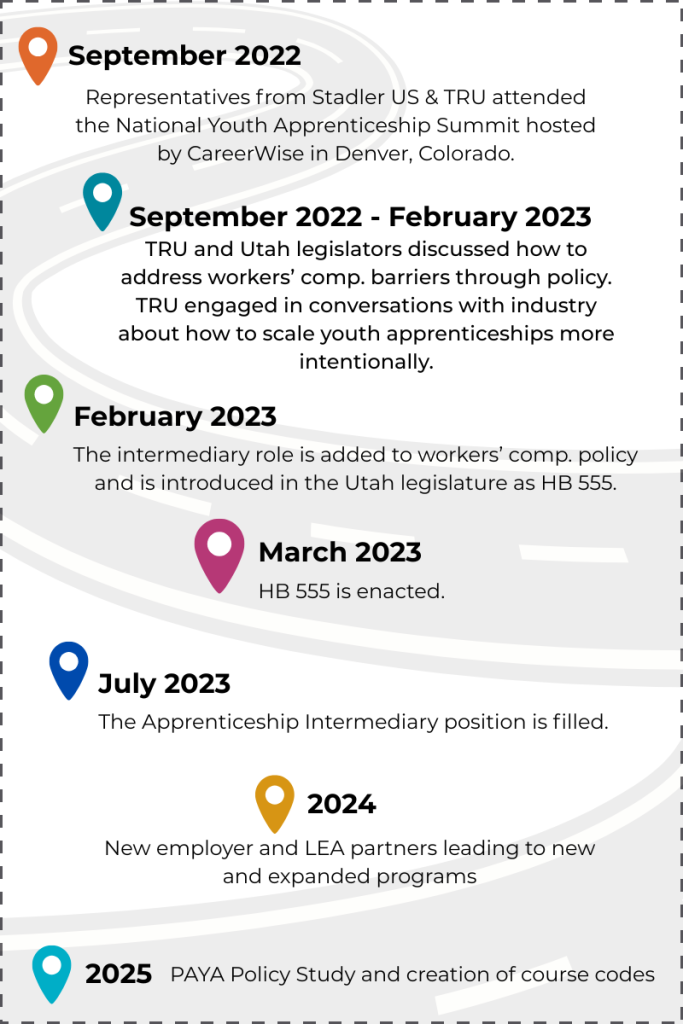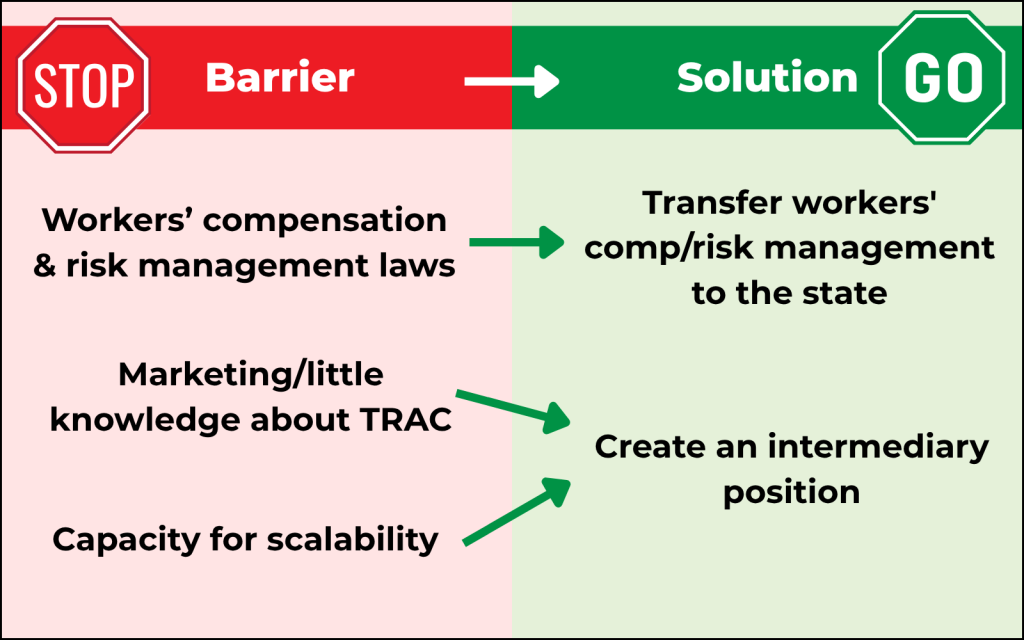Before the passage of Utah House Bill 555 (H.B. 555; 2023), employers in Utah were responsible for workers’ compensation and risk management liability for “student workers” in paid positions, while unpaid student workers were covered by the local education agency (LEA). H.B. 555 reclassified all student workers—paid or unpaid—as volunteer government workers, relieving employers of both responsibilities. Now, workers’ compensation is provided through the LEAs’ local coverage providers, and risk management liability is handled by the Utah State Risk Management Fund.
Before the passage of HB 555, apprenticeship programs were siloed and limited to certain industry sectors. This law created an apprenticeship intermediary position through the Utah System of Higher Education’s (USHE) Talent Ready Utah (TRU) to foster relationships between their Talent Ready Apprenticeship Connection (TRAC) program and LEAs.
The intermediary’s role is two-fold: recruit employers to create or scale their apprenticeship programs through TRAC and coordinate with LEAs to connect learners to work-based learning (WBL) opportunities offered through TRU, including TRAC.
Launched in 2019, TRAC is a Swiss-inspired youth apprenticeship model that allows learners to obtain meaningful work experiences by splitting their time between the classroom and the workplace. Under TRAC, learners are connected to paid apprenticeships and are prepared to meet growing workforce demands.

Keep reading to discover how H.B. 555
- Took steps for apprenticeships to be fully integrated into the education system.
- Overcame barriers for workers’ compensation and risk management state laws that often pose challenges for employer participation in WBL and apprenticeship programs.
- Highlighted the critical role of Intermediaries in system-wide apprenticeship expansion.
- Reversed a lack of youth apprenticeship course codes in the state’s education system to fully count participation for learners and employers.
- Exposed additional considerations and resources needed to sustain apprenticeship programs beyond the initial implementation.
Behind The Scenes: The Road to HB 555
As TRAC’s first employer partner, Swiss-based company Stadler US aimed to bring the Swiss apprenticeship model to Utah. Unlike the American model, Swiss apprenticeships are fully integrated into multiple learner levels, combining in-class instruction with hands-on training at a company starting in high school and continuing into college. In partnership with TRU, Stadler helped develop the Advanced Manufacturing apprenticeship model, laying the foundation for more integrated WBL starting in high school and continuing into a postsecondary experience.
However, as TRU sought to transition TRAC to a fully developed program with multiple industry lanes, the need for an intermediary became apparent. Elsewhere, workers’ compensation and risk management laws posed a huge challenge for employers to take advantage of such a model.

At a CareerWise advising conference in Colorado, representatives from TRU and Stadler learned more about the critical role intermediaries play in system-wide apprenticeship expansion. Following that event, both parties agreed to establish a dedicated intermediary role housed at TRU to connect learners with apprenticeship opportunities and support employers in adopting and scaling TRAC-aligned programs.
With a governing board functioning simultaneously as a subcommittee under Utah’s Governor’s Commission, a state senator serving as board chair, and a statutory mandate to address gaps through policy, TRU was well-positioned to address TRAC-related challenges through policy. Utah HB 555 was enacted in March 2023, with one of the authors being TRU’s board chair, State Senator Ann Millner.

Implementation: The Intermediary’s Role & Responsibilities
The intermediary position was filled by Amy Andre, the representative from Stadler who attended the CareerWise conference. With firsthand experience navigating the challenges in scaling apprenticeships from the employer’s perspective, Amy became the vehicle through which the vision would be realized.

This position oversees TRAC, as well as all of TRU’s pathway programs. The role and responsibilities include:
- Developing relationships with district CTE directors, the Utah System of Higher Education, and industry partners.
- Curating spaces to learn and exchange partner concerns, challenges, and needs. Identifying gaps in workforce pipelines and aligning them with current and emerging CTE pathways.
- Assisting in the registration of new youth apprenticeship programs with TRAC, including tracking learners and maintaining compliance with state regulations.
- Matching learners with employers, supporting marketing and recruitment efforts, and troubleshooting implementation barriers with school districts.
The Intermediary’s Impact
With LEAs looking to prepare learners to meet workforce demands and workers’ compensation/risk management no longer posing a barrier for employers, H.B. 555 became a tool for LEAs to engage with employers, resulting in new education and industry partnerships through and beyond TRAC.
The apprenticeship intermediary directly facilitated or strongly influenced the following TRAC program improvements—
- Secured three new employer partners to participate in the Advanced Manufacturing TRAC program;
- Expanded the Advanced Manufacturing TRAC program to rural Utah by establishing new partnerships with a LEA, a higher education institution, and a regional employer;
- Designed two new TRAC programs in the health care and hospitality industries;
- Secured one employer partner each in the health care and hospitality sectors to support implementation of the new TRAC programs;
- Formed partnerships with two additional LEAs to offer the Advanced Manufacturing TRAC program to learners in their school districts.
TRU currently has 1,033 learners enrolled in its Diesel Tech Pathway. In 2025, TRU graduated 73 learners from the Aerospace Pathway and 14 learners from the TechSales Pathway.

Additionally, the apprenticeship intermediary, in collaboration with the Utah State Board of Education, the Department of Workforce Services, and the Partnership to Advance Youth Apprenticeship’s Policy Academy, conducted a study that revealed critical gaps in TRAC’s infrastructure. One of the most significant barriers explored was the lack of youth apprenticeship course codes in the state’s education system. Without these codes, there was no formal mechanism to classify TRAC participants as youth apprentices and provide accurate secondary credit for their experience. The team created youth apprenticeship course codes for every TRAC program to accurately track learner participation, ensure that learners receive transcripted credit, and allow employers to legally and confidently leverage the protections provided by H.B. 555.
TRU plans to launch its health care and hospitality TRAC programs in the 2025-2026 school year. Additionally, two new LEA partners will join the Salt Lake Advanced Manufacturing TRAC program, each planning to have at least three additional employer partners. With more employer buy-in, TRU also plans to relaunch its Construction Pathway in fall 2025.
Gaps and Future Considerations
While the apprenticeship intermediary worked to expand TRAC overtime, the position initially focused on discovering and addressing challenges that hindered the implementation of TRAC. The following areas remain a challenge that TRU looks to address in the near future:
- Sustainability mechanisms: While H.B. 555 created the role, it did not establish data systems to track cross-sector impact or codify data-sharing processes.
- Balancing access and preparedness: While the intermediary role has been pivotal in increasing learners’ access to apprenticeships, additional consideration of logistics between LEAs and employers is needed to ensure that learners are not missing pertinent information in the classroom or at the work site.
- Program expansion: The responsibilities of the intermediary expand far beyond the capacity of an individual. More capacity is needed to scale and sustain TRAC and the assistance offered to its partners.

